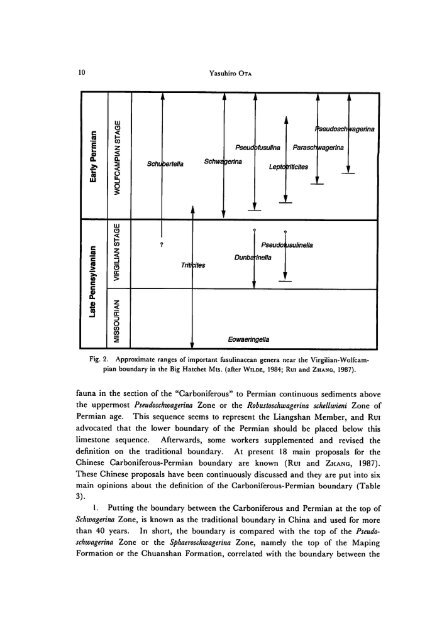Biostratigraphy of the Akiyoshi Limestone Group,
Biostratigraphy of the Akiyoshi Limestone Group,
Biostratigraphy of the Akiyoshi Limestone Group,
You also want an ePaper? Increase the reach of your titles
YUMPU automatically turns print PDFs into web optimized ePapers that Google loves.
10 Yasuhiro Ota<br />
U Jl i t i L ii<br />
UJ 4<br />
CD<br />
c<br />
a 1-<br />
1<br />
co<br />
z<br />
Pseud<strong>of</strong>usulina<br />
<<br />
Q. a.<br />
•V*<br />
<<br />
/ 'seudoschif/agerina<br />
<<br />
.3<br />
_i<br />
§<br />
Schubertella<br />
Schwdgerina<br />
ir<br />
ii ,, -J-<br />
LeptoWffc/tes<br />
"<br />
Parasch vagerina<br />
f<br />
w<br />
c<br />
a<br />
c<br />
UJ<br />
CD 9 o<br />
<<br />
r-<br />
CO<br />
<br />
Pseudoi usulinella<br />
z<br />
<<br />
"1<br />
Dunba inella<br />
> 5 Tr/fii ;/fes<br />
>.<br />
a: V<br />
CO ><br />
c<br />
c<br />
' f<br />
a><br />
a<br />
© z<br />
•9 <<br />
3<br />
rr<br />
O<br />
CO<br />
CO<br />
Eowaeringella<br />
1<br />
'<br />
Fig. 2. Approximate ranges <strong>of</strong> important fusulinacean genera near <strong>the</strong> Virgilian-Wolfcam<br />
pian boundary in <strong>the</strong> Big Hatchet Mts. (after Wilde, 1984; Rui and Zhang, 1987).<br />
fauna in <strong>the</strong> section <strong>of</strong> <strong>the</strong> "Carboniferous" to Permian continuous sediments above<br />
<strong>the</strong> uppermost Pseudoschwagerina Zone or <strong>the</strong> Robustoschwagerina schellwieni Zone <strong>of</strong><br />
Permian age. This sequence seems to represent <strong>the</strong> Liangshan Member, and Rui<br />
advocated that <strong>the</strong> lower boundary <strong>of</strong> <strong>the</strong> Permian should be placed below this<br />
limestone sequence. Afterwards, some workers supplemented and revised <strong>the</strong><br />
definition on <strong>the</strong> traditional boundary. At present 18 main proposals for <strong>the</strong><br />
Chinese Carboniferous-Permian boundary are known (Rui and Zhang, 1987).<br />
These Chinese proposals have been continuously discussed and <strong>the</strong>y are put into six<br />
main opinions about <strong>the</strong> definition <strong>of</strong> <strong>the</strong> Carboniferous-Permian boundary (Table<br />
3).<br />
1. Putting <strong>the</strong> boundary between <strong>the</strong> Carboniferous and Permian at <strong>the</strong> top <strong>of</strong><br />
Schwagerina Zone, is known as <strong>the</strong> traditional boundary in China and used for more<br />
than 40 years. In short, <strong>the</strong> boundary is compared with <strong>the</strong> top <strong>of</strong> <strong>the</strong> Pseudo<br />
schwagerina Zone or <strong>the</strong> Sphaeroschwagerina Zone, namely <strong>the</strong> top <strong>of</strong> <strong>the</strong> Maping<br />
Formation or <strong>the</strong> Chuanshan Formation, correlated with <strong>the</strong> boundary between <strong>the</strong>
















